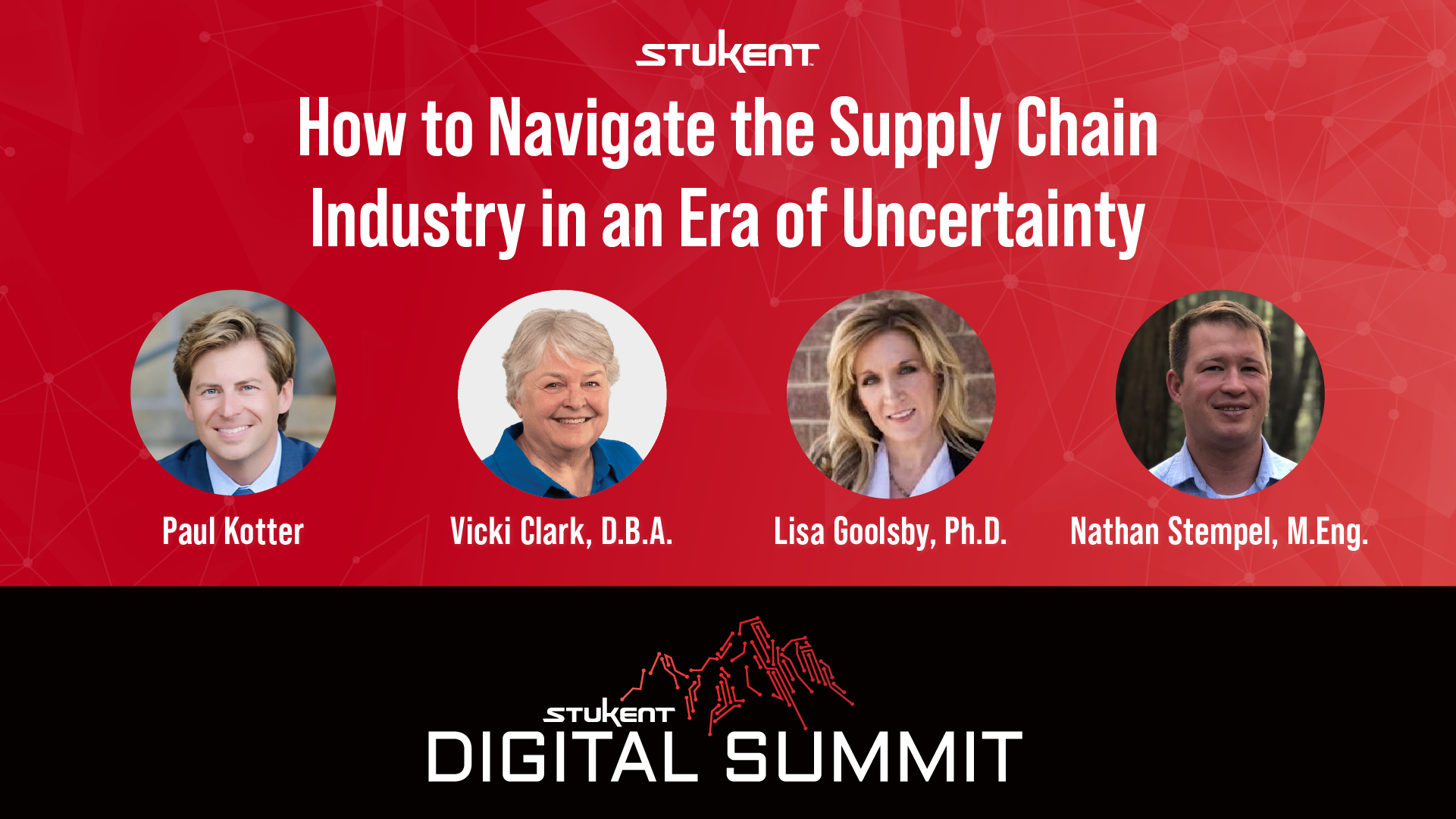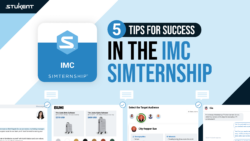Navigating the supply chain industry can be incredibly challenging for those just graduating and entering this business sector. The Stukent® community joined three supply chain experts in a panel discussion to speak on the latest trends and challenges in their industry. If you missed the panel discussion, watch it here. Or, read on for a recap of their responses!
Supply Chain Trends and Challenges in 2023
Can you share a major disruption in your industry and what factors you believe contributed to it?
Nathan Stempel, a seasoned consultant and entrepreneur, began by discussing a disruption he faced in the semiconductor industry. His startup relied on near-field communication technology, which required RFID chips. While he initially thought his supply chain was robust, he discovered a vulnerability. The RFID supply chain had a diamond shape, with only a few silicone manufacturers at the top. When COVID-19 disrupted the silicone industry, everything upstream was at risk. As a result, he had to cancel several pilots due to extended lead times for silicone manufacturing. Nathan emphasized the importance of deep supply chain analysis for anticipating disruptions.
With over 30 years of industry experience, Vicki Clark shared insights on transportation disruptions. She highlighted the situation at the Panama Canal, where a drought significantly reduced the number of ships passing through the locks. This situation had the potential to cause blockages in the transportation of goods, impacting about 40% of container volume in the United States. Vicki also mentioned that the closure of Yellow Freight after 99 years was significant. She attributed this to failing to integrate various acquired companies, leading to a lack of economies of scale.
Lisa Goolsby, with a background in marketing and coffee bar ownership, discussed challenges faced by small businesses during COVID-19. She experienced long lead times for essential supplies like cups, which were in short supply. To cope, her coffee bars encouraged customers to bring their own cups and offered discounts on refills. Lisa also highlighted labor shortages at suppliers’ facilities, resulting in uncertain orders and shipments.
Vicki Clark, as someone in the logistics and transportation industry, can you share your thoughts on the closure of Yellow Freight after 99 years of operation? How do you think this event will affect other transportation channels in the near future?
Vicki expressed her sadness at seeing a historic company shut down. However, she pointed out that Yellow Freight had acquired several companies but needed to integrate them effectively.
“Freight was a good business to be in, so they didn’t make any adjustments to take economies to scale and to take advantage of what they had there that worked together,” Vicki said. “They were still very much individual companies, and I think they realized too little too late.”
This lack of integration and operational inefficiencies led to their downfall. Vicki also mentioned that other regional carriers, like Saia Motor Freight, have seen increased business due to Yellow Freight’s closure. She encouraged companies to consolidate shipments and explore alternatives during disruptions.
Lisa and Nathan shared additional concerns from their respective perspectives. Lisa emphasized the importance of having multiple suppliers and using platforms like Amazon Business for sourcing. Nathan highlighted the impact of disruptions on freight trucking, which affects most industries. He emphasized the need for increased transparency and systematic anticipation of disruptions using technology and data analysis.
Leveraging Data Analytics for Supply Chain Optimization
How will data analytics improve various aspects of the supply chain industry?
Nathan emphasized the importance of strategic thinking when it comes to data analytics. He used the example of a commodities distributor wanting to optimize delivery routes in rural areas of India. To achieve this, they needed real-time fleet tracking, which required investing in GPS trackers for their trucks. Nathan stressed the need for smart investments in data that align with strategic goals.
“I look at the outcome [and] I make sure it’s tied to a competitive advantage,” Nathan said. “Then I walk back to making sure we’re making smart investments on data that matters.”
Vicki emphasized the importance of analyzing data to reduce transit times, optimize warehouse locations, and make informed decisions regarding inventory management. She encouraged students to interpret data effectively to drive better supply chain outcomes.
Lisa talked about the practical use of data analytics. She explained how her coffee shops rely on point-of-sale data to track sales of different cup sizes, enabling them to manage inventory efficiently. Lisa emphasized the significance of just-in-time inventory and inventory turnover for small businesses.
She shared a real-world example of a matcha shortage and how data analytics helped them address it by monitoring demand and ensuring proper stock management.
“Lately, we’ve had an issue with matcha,” Lisa said. “I don’t know if anybody’s familiar with matcha, but it’s big in demand at coffee bars, and my supplier hasn’t had any. We’ve been able to get small samples of it, and so I had to send out a memo to my employees to say, ‘Please save it for the customers; do not use it for your shift drink,’ because it’s not an inexpensive item, and I want to see it move. I want my customers to keep coming, and we’re out of stock on something that becomes problematic. So, just really looking at the analytics from our point of sale to know what moves, what doesn’t, and where we need to have some of that safety stock.”
Sustainable Supply Chains and Environmental Concerns
Many companies are now rethinking their practices due to increasing environmental concerns. What are your thoughts on how sustainable practices can help build long-term resilience?
Lisa highlighted how sustainability efforts can contribute to resilience. She again mentioned the idea of incentivizing customers to use reusable cups and offering discounts. This reduces the consumption of disposable paper and plastic and ensures a more reliable supply of cups during shortages. Lisa also emphasized using local suppliers to enhance resilience by minimizing distribution and freight challenges.
Vicki Clark discussed sustainability from a packaging perspective. She noted that major companies like Walmart and Amazon are improving packaging practices by using machines to create the right-sized packages, and other companies are using biodegradable packaging.
“I think we’re just seeing a lot more [sustainable packaging] and a lot more interest in doing it,” Vicki said. “Is it more expensive? Yeah, it is. It’s not as cheap as packaging peanuts. So, there’s always a trade-off, but if as a corporation you count yourself as being environmentally focused, then you need to walk the walk as well as talk the talk.”
Nathan mentioned that regulations, like the European Union’s extended producer responsibilities, are pushing companies to consider the end-of-life disposal of products.
“When you think circular economy, there are second lives for valuable products that aren’t necessarily the life the original manufacturer intended it to be,” Nathan said. “When you start thinking about these ways to repurpose material, you start introducing new revenue streams, and that kind of sustainability can be profitable for a company when they take that approach.”
Launch Strategies to Navigate Unpredictability
The supply chain industry has faced a lot of turmoil in the past few years. How are companies adjusting their supply chain strategies to cope with persistent unpredictability?
Nathan highlighted the need to create transparency and identify leading indicators to foresee disruptions before they occur. He also noted the challenge of balancing cost efficiency with resiliency and reliability. He stressed the significance of effective communication and storytelling within an organization to justify strategic decisions.
“One of the things that I’ve had to do is always have multiple backup plans,” Lisa said. “I’ve got multiple suppliers, so if there are issues, I have several different plans for what could happen or go wrong. You need to have multiple sources and several different plans for different scenarios. Safety stock on critical items is important. It’s all about being prepared.”
Vicki discussed how she managed to pivot and prepare for a potential UPS strike by proactively shifting volume to FedEx and securing additional trailers. She accomplished this by monitoring data and building relationships with suppliers and sales representatives to anticipate disruptions. She encouraged students to embrace the dynamic nature of supply chain management and highlighted the potential for success through adaptability.
Stukent Digital Summit: Supply Chain was held online on August 18, 2023. If you want to see Stukent’s upcoming events, visit the Events page on our website.
Stukent is here to help educators help students help the world. To learn more about our first-in-the-world Simternships™ and courseware, or to get FREE instructor access to our products, visit our website.






